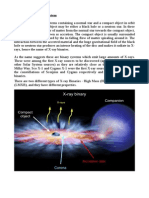Assignment 4: Taylor Pearce 3/05/10 Elsa Johnson
Assignment 4: Taylor Pearce 3/05/10 Elsa Johnson
Uploaded by
Aravind BhomboreCopyright:
Available Formats
Assignment 4: Taylor Pearce 3/05/10 Elsa Johnson
Assignment 4: Taylor Pearce 3/05/10 Elsa Johnson
Uploaded by
Aravind BhomboreOriginal Description:
Original Title
Copyright
Available Formats
Share this document
Did you find this document useful?
Is this content inappropriate?
Copyright:
Available Formats
Assignment 4: Taylor Pearce 3/05/10 Elsa Johnson
Assignment 4: Taylor Pearce 3/05/10 Elsa Johnson
Uploaded by
Aravind BhomboreCopyright:
Available Formats
Assignment 4
Taylor Pearce 3/05/10 Elsa Johnson 1. Because astronomers cannot directly observe or detect black holes they are found by examining their interactions with matter around them. Black holes have an infinite amount of mass in a small space this creates a very strong gravitational field. Stellar objects orbiting this strong gravitational field will either fall into the black hole or if their speed is high enough they will continue to orbit the black hole. The interaction between orbit time and mass can be used to calculate the mass of the unseen black hole verifying that the only object that could have that much of a gravitational effect on an object must be a black hole. Black holes can also be detected when matter is falling into its gravitational field. Matter will collect around the black hole in the accretion disk where it will heat up to very high temperatures and emit high energy x-rays. By searching for these x-rays is how astronomers can locate black holes.
2. Binary Neutron stars are neutron stars with a normal, white dwarf, or neutron star companion. When these two orbiting stars get close enough the neutron star will begin to remove matter from its neighboring star emitting x-rays much like a black hole. Pairs of neutron stars are thought to be the source of gravitational waves. When a neutron star removes enough matter from its companion it will explode in a type Ia supernova. This is a very specific supernova and has a constant luminosity. This aspect is very useful for measuring distances because the type Ia supernova is bright enough to be seen and has a known luminosity.
3.
4. Large Black Hole Density
Small Black Hole Density
I was really surprised by the density difference of the black holes. Because they are so dense I thought they would have densities that were much more closely related. But it turned out that the lower mass black hole had a much greater density than the high mass black hole. 5. The last supernova to occur in the milky way was 140 years ago and located about 26,000 light-years away. On average supernovae occur ever 50-100 years in a given galaxy. Based upon the data it appears that our galaxy is overdue for a supernova. Apparently we should have had a supernova forty years ago. Our galaxy is supernova deficient.
You might also like
- IMRAD - Black HolesDocument8 pagesIMRAD - Black HolesFranchesca ValerioNo ratings yet
- The Probable Evolution of Black Holes, Galactic Cores, & QuasarsDocument7 pagesThe Probable Evolution of Black Holes, Galactic Cores, & QuasarsKeith D. FooteNo ratings yet
- Black Holes: By: Hoor Al-Naser - Mariam Kidwai - Randa Altharman Class: 11/A Subject: Honors ChemistryDocument11 pagesBlack Holes: By: Hoor Al-Naser - Mariam Kidwai - Randa Altharman Class: 11/A Subject: Honors ChemistryMariam KidwaiNo ratings yet
- BLACK HOLE ReportDocument37 pagesBLACK HOLE ReportJhonel CastanedaNo ratings yet
- Black Hole & SupernovaDocument24 pagesBlack Hole & SupernovaandreasaryasatyaNo ratings yet
- Introduction To Black Holes and Gravitational WavesDocument11 pagesIntroduction To Black Holes and Gravitational Waveskumar.rishabh.y2008No ratings yet
- Astronomy HomeworkDocument4 pagesAstronomy HomeworkAyus PraharajNo ratings yet
- Black HolesDocument27 pagesBlack HolesNikolas ŠkrljNo ratings yet
- Black HoleDocument2 pagesBlack HoleUmar AfzalNo ratings yet
- Black HolesDocument13 pagesBlack HolesCataSalvàNo ratings yet
- What Is A Black Hole?Document5 pagesWhat Is A Black Hole?rogelio93No ratings yet
- Black Holes - Docx by BUNDocument4 pagesBlack Holes - Docx by BUNkenbuna48No ratings yet
- X-Ray Binaries JetsDocument4 pagesX-Ray Binaries JetsZain RahimNo ratings yet
- I Am Sharing 'Presentation (1) ' With YouDocument17 pagesI Am Sharing 'Presentation (1) ' With Youmakarov.2023.3202No ratings yet
- Proyecto - FísicaDocument3 pagesProyecto - FísicamayarisolistolamaNo ratings yet
- Death of StarsDocument0 pagesDeath of Starshotrdp5483No ratings yet
- Matière Noire Et Énergie SombreDocument8 pagesMatière Noire Et Énergie SombreNinaNo ratings yet
- Black HolesDocument3 pagesBlack HolesFitri Aulia Permatasari100% (1)
- Black ?Document8 pagesBlack ?bobNo ratings yet
- Black Holes: Intense X-Ray Flares Thought To Be Caused by A Black Hole Devouring A Star. (Video)Document5 pagesBlack Holes: Intense X-Ray Flares Thought To Be Caused by A Black Hole Devouring A Star. (Video)Karthikeyan VenugopalNo ratings yet
- A Celestial Loner Might Be The First Known Rogue Black Hole - Science NewsDocument4 pagesA Celestial Loner Might Be The First Known Rogue Black Hole - Science NewsGouriJayanNo ratings yet
- Physics ProjectDocument12 pagesPhysics ProjectWasif AhmedNo ratings yet
- Black Holes - Everything You Need To Know - Modul CititorDocument1 pageBlack Holes - Everything You Need To Know - Modul CititorCamelia DobreanNo ratings yet
- What Is Black Hole ?: Credits: NASA/CXC/M.WeissDocument5 pagesWhat Is Black Hole ?: Credits: NASA/CXC/M.WeissLeonardo VinciNo ratings yet
- NASA Black Hole ShortDocument5 pagesNASA Black Hole ShortAndrej Vuk BlesićNo ratings yet
- Black HolesDocument2 pagesBlack HolesХОРОШОNo ratings yet
- The Very End of Space and Time: Black HoleDocument6 pagesThe Very End of Space and Time: Black HolekashimotocomotuyaNo ratings yet
- Are We Really All Made of Stars?: Sagan Famously StatedDocument8 pagesAre We Really All Made of Stars?: Sagan Famously StatedYASSINNo ratings yet
- Dark Matter Astronomy Extended DefinitionDocument4 pagesDark Matter Astronomy Extended DefinitionTrisha Mae LocsonNo ratings yet
- BLACKHOLEDocument2 pagesBLACKHOLEsujatarath65No ratings yet
- Phy Project On Dark Matter and Dark EnergyDocument11 pagesPhy Project On Dark Matter and Dark EnergyGagan .SNo ratings yet
- AstronomyDocument2 pagesAstronomyMa Jhoylene Alejandro DecanoNo ratings yet
- Black Hole!!Document11 pagesBlack Hole!!Mrityunjay DubeyNo ratings yet
- Black Holes PDFDocument3 pagesBlack Holes PDFAnonymous 3RtRJ1OYNo ratings yet
- Lack Oles: Read The Full ArticleDocument5 pagesLack Oles: Read The Full ArticleDaniel Rendón MontesNo ratings yet
- Black HolesDocument2 pagesBlack HolesJapheth SolaresNo ratings yet
- Black Holes Are Some of The Strangest and Most Fascinating Objects in Outer Space. They're ExtremelyDocument3 pagesBlack Holes Are Some of The Strangest and Most Fascinating Objects in Outer Space. They're Extremelyneoo svttNo ratings yet
- Astronomy Science in The News JournalDocument18 pagesAstronomy Science in The News Journalapi-294784480No ratings yet
- Andrea Ghez - The Hunt For A Supermassive Black hol-WT - SummariesDocument11 pagesAndrea Ghez - The Hunt For A Supermassive Black hol-WT - SummariespsfsdhfNo ratings yet
- Science MagazineDocument6 pagesScience Magazinealchemypinkal70700No ratings yet
- Association Between Supernova Remnants and PulsarsDocument16 pagesAssociation Between Supernova Remnants and PulsarsGadhadar ReddyNo ratings yet
- Black HoleDocument3 pagesBlack Holeaashhs kechuoNo ratings yet
- Essay On Black HolesDocument9 pagesEssay On Black HolesJae Hyuk KIMNo ratings yet
- Dark Matter: Matt Cannon (928) Physics 222 2/15/02 Final DraftDocument9 pagesDark Matter: Matt Cannon (928) Physics 222 2/15/02 Final DraftDenmark CabadduNo ratings yet
- Pulsar Stars (Space)Document12 pagesPulsar Stars (Space)Krish_666No ratings yet
- Black HolesDocument2 pagesBlack HolesJulio ChirinosNo ratings yet
- Black HolesDocument6 pagesBlack HolesManpreet SinghNo ratings yet
- Slow Down! "Antimatter?" "Pure Energy?" What Is This, Star Trek?Document7 pagesSlow Down! "Antimatter?" "Pure Energy?" What Is This, Star Trek?Malkit SinghNo ratings yet
- The Secrets of Black Holes - Davidson Institute of Science EducationDocument8 pagesThe Secrets of Black Holes - Davidson Institute of Science Educationתומר אדריNo ratings yet
- XDocument34 pagesXPrince arslanNo ratings yet
- Event HorizonDocument15 pagesEvent Horizonraxacoc381No ratings yet
- Physics NotesDocument2 pagesPhysics NotesAnkit RajNo ratings yet
- Black Holes ResearchDocument3 pagesBlack Holes ResearchshioriNo ratings yet
- Evidence of Dark MatterDocument3 pagesEvidence of Dark MatterCameron GrahamNo ratings yet
- The UniverseDocument3 pagesThe UniverseZing TeoNo ratings yet
- What Is A Black Hole?Document10 pagesWhat Is A Black Hole?Bhavith 1524No ratings yet
- Supernova and PulsarsDocument15 pagesSupernova and PulsarsGadhadar ReddyNo ratings yet
- BH PrimerDocument4 pagesBH PrimerAleatorioNo ratings yet
- Black Hole: How Big Are Black Holes?Document2 pagesBlack Hole: How Big Are Black Holes?Muhammad HassanNo ratings yet
- WWW Pcrepairnorthshore ComDocument5 pagesWWW Pcrepairnorthshore ComAravind BhomboreNo ratings yet
- Hand To His Heart As Though To Keep It From Bursting He Perfectly Understood Her and HerDocument1 pageHand To His Heart As Though To Keep It From Bursting He Perfectly Understood Her and HerAravind BhomboreNo ratings yet
- MOCK XAT 2-cDocument22 pagesMOCK XAT 2-cAravind BhomboreNo ratings yet
- 2014-II Ndana General Ability Solved PaperDocument16 pages2014-II Ndana General Ability Solved PaperAravind BhomboreNo ratings yet
- Bank Po Phase-I Mock Test-18 (Solution) : ReasoningDocument6 pagesBank Po Phase-I Mock Test-18 (Solution) : ReasoningAravind BhomboreNo ratings yet
- Phy 12 (Ncert)Document10 pagesPhy 12 (Ncert)Aravind BhomboreNo ratings yet
- Question Paper Bank Po 23Document18 pagesQuestion Paper Bank Po 23Aravind BhomboreNo ratings yet
- IBPS PO Computer DigestDocument28 pagesIBPS PO Computer DigestAravind BhomboreNo ratings yet
- Question Paper Bank Po 17Document33 pagesQuestion Paper Bank Po 17Aravind BhomboreNo ratings yet
- Radix SortDocument2 pagesRadix SortAravind BhomboreNo ratings yet
- Linux TCP WrappersDocument1 pageLinux TCP WrappersAravind BhomboreNo ratings yet
- Question Paper SSC 17Document22 pagesQuestion Paper SSC 17Aravind BhomboreNo ratings yet
- Wave OpticsDocument9 pagesWave OpticsDhilipan RamachandranNo ratings yet








































































